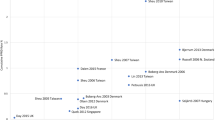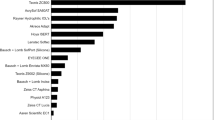Abstract
Purpose
To determine the long-term incidence of pseudophakic retinal detachment (PRD) after phacoemulsification and the weight of the main risk factors in the appearance of such complication in a large sample. To implement a customized formula and a software calculation program able to quantify the risk of suffering PRD applicable to all lens extraction patients.
Methods
Retrospective cumulative risk analysis conducted on 178,515 eyes operated under similar conditions in a group of refractive surgery clinics (Clínica Baviera SL) located in a relatively limited geographical area (Spain). A survival analysis was performed and the data were modelled using the Weibull regression to determine the risk over a period of 16 years and to estimate the association of different risk factors: sex, age, axial length (AXL) of the eye, intraoperative posterior capsule rents (PCR), and YAG laser capsulotomies. The resulting estimates were translated into a predictive equation for hazard rates and survival probabilities. Later, an application was developed to make prediction available for the clinical community in order to estimate the potential risk of any hypothetical case before lens surgery.
Results
Globally, 1521 (0.85%) cases of PRD were diagnosed during the period. The risk for PRD was significantly greater in males (5.48 [2.94–10.2]; p < 0.001), in long eyes (1.24 [1.21–1.26]; p < 0.001), and also after posterior capsule rents (13.97 [11.61–16.82]; p < 0.001). Posterior capsule rupture increased the risk of PRD up to fourteen times.
Conclusions
From weaker to stronger impact, age, axial length, sex, and intraoperative posterior capsule rent were significant risk factors for the appearance of PRD after lens extraction.








Similar content being viewed by others
References
Petousis V, Sallam AA, Haynes RJ, Patel CK, Tyagi AK, Kirkpatrick JN, Johnston RL (2016) Risk factors for retinal detachment following cataract surgery: the impact of posterior capsular rupture. Br J Ophthalmol 100(11):1461–1465. https://doi.org/10.1136/bjophthalmol-2015-307729
Alio JL (2011) Lens surgery (cataract and refractive lens exchange) and retinal detachment risk in myopes: still an issue? Br J Ophthalmol 95(3):301–303. https://doi.org/10.1136/bjo.2010.186429
Jakobsson G, Montan P, Zetterberg M, Stenevi U, Behndig A, Lundstrom M (2009) Capsule complication during cataract surgery: retinal detachment after cataract surgery with capsule complication: Swedish Capsule Rupture Study Group report 4. J Cataract Refract Surg 35(10):1699–1705. https://doi.org/10.1016/j.jcrs.2009.05.028
Ripandelli G, Scassa C, Parisi V, Gazzaniga D, D’Amico DJ, Stirpe M (2003) Cataract surgery as a risk factor for retinal detachment in very highly myopic eyes. Ophthalmology 110(12):2355–2361. https://doi.org/10.1016/s0161-6420(03)00819-4
Russell M, Gaskin B, Russell D, Polkinghorne PJ (2006) Pseudophakic retinal detachment after phacoemulsification cataract surgery: ten-year retrospective review. J Cataract Refract Surg 32(3):442–445. https://doi.org/10.1016/j.jcrs.2005.12.095
Neuhann IM, Neuhann TF, Heimann H, Schmickler S, Gerl RH, Foerster MH (2008) Retinal detachment after phacoemulsification in high myopia: analysis of 2356 cases. J Cataract Refract Surg 34(10):1644–1657. https://doi.org/10.1016/j.jcrs.2008.06.022
Sheu SJ, Ger LP, Chen JF (2007) Male sex as a risk factor for pseudophakic retinal detachment after cataract extraction in Taiwanese adults. Ophthalmology 114(10):1898–1903. https://doi.org/10.1016/j.ophtha.2007.02.030
Bhagwandien AC, Cheng YY, Wolfs RC, van Meurs JC, Luyten GP (2006) Relationship between retinal detachment and biometry in 4262 cataractous eyes. Ophthalmology 113(4):643–649. https://doi.org/10.1016/j.ophtha.2005.10.056
Daien V, Le Pape A, Heve D, Carriere I, Villain M (2015) Incidence, risk factors, and impact of age on retinal detachment after cataract surgery in France: a national population study. Ophthalmology 122(11):2179–2185. https://doi.org/10.1016/j.ophtha.2015.07.014
Kassem R, Greenwald Y, Achiron A, Hecht I, Man V, Ben Haim L, Bukelman A (2018) Peak occurrence of retinal detachment following cataract surgery: a systematic review and pooled analysis with internal validation. J Ophthalmol 2018:9206418. https://doi.org/10.1155/2018/9206418
Clark A, Morlet N, Ng JQ, Preen DB, Semmens JB (2012) Risk for retinal detachment after phacoemulsification: a whole-population study of cataract surgery outcomes. Arch Ophthalmol 130(7):882–888. https://doi.org/10.1001/archophthalmol.2012.164
Lin JY, Ho WL, Ger LP, Sheu SJ (2013) Analysis of factors correlated with the development of pseudophakic retinal detachment--a long-term study in a single medical center. Graefes Arch Clin Exp Ophthalmol 251(2):459–465. https://doi.org/10.1007/s00417-012-2043-3
Boberg-Ans G, Henning V, Villumsen J, la Cour M (2006) Longterm incidence of rhegmatogenous retinal detachment and survival in a defined population undergoing standardized phacoemulsification surgery. Acta Ophthalmol Scand 84(5):613–618. https://doi.org/10.1111/j.1600-0420.2006.00719.x
Day AC, Donachie PHJ, Sparrow JM, Johnston RL (2016) United Kingdom National Ophthalmology Database Study of ctaract surgery: report 3: pseudophakic retinal detachment. Ophthalmology 123(8):1711–1715. https://doi.org/10.1016/j.ophtha.2016.04.002
Stein JD, Grossman DS, Mundy KM, Sugar A, Sloan FA (2011) Severe adverse events after cataract surgery among medicare beneficiaries. Ophthalmology 118(9):1716–1723. https://doi.org/10.1016/j.ophtha.2011.02.024
Qureshi MH, Steel DHW (2020) Correction: retinal detachment following cataract phacoemulsification-a review of the literature. Eye (Lond) 34(4):787. https://doi.org/10.1038/s41433-019-0635-4
Team RC (2013) R: a language and environment for statistical computing. R Foundation for Statistical Computing. URL https://www.R-project.org/. Accessed 06/12/2020
Austin PC, Harrell FE Jr, van Klaveren D (2020) Graphical calibration curves and the integrated calibration index (ICI) for survival models. Stat Med 39(21):2714–2742. https://doi.org/10.1002/sim.8570
Harrell JRF, E. (2015) Regression modeling strategies: with applications to linear models, logistic and ordinal regression, and survival analysis. Springer, New York
Alio JL, Ruiz-Moreno JM, Shabayek MH, Lugo FL, Abd El Rahman AM (2007) The risk of retinal detachment in high myopia after small incision coaxial phacoemulsification. Am J Ophthalmol 144(1):93–98. https://doi.org/10.1016/j.ajo.2007.03.043
Laube T, Brockmann C, Lehmann N, Bornfeld N (2017) Pseudophakic retinal detachment in young-aged patients. PLoS One 12(8):e0184187. https://doi.org/10.1371/journal.pone.0184187
Kerkhoff FT (2019) Rhegmatogenous retinal detachment after cataract or refractive lens extraction. https://fyeomedical.nl/retinal-detachment/. Accessed 27th/March/2020
Javaloy J, Rivera E, Montalban R, Beltran J, Munoz G, Rohrweck S (2019) Diffractive trifocal pseudophakic intraocular lenses in high myopic eyes: 2-year assessment after implantation. Graefes Arch Clin Exp Ophthalmol 257(6):1331–1339. https://doi.org/10.1007/s00417-019-04302-5
Ripandelli G, Coppe AM, Parisi V, Olzi D, Scassa C, Chiaravalloti A, Stirpe M (2007) Posterior vitreous detachment and retinal detachment after cataract surgery. Ophthalmology 114(4):692–697. https://doi.org/10.1016/j.ophtha.2006.08.045
Yonemoto J, Ideta H, Sasaki K, Tanaka S, Hirose A, Oka C (1994) The age of onset of posterior vitreous detachment. Graefes Arch Clin Exp Ophthalmol 232(2):67–70. https://doi.org/10.1007/bf00171665
Agarkar S, Gokhale VV, Raman R, Bhende M, Swaminathan G, Jain M (2018) Incidence, risk factors, and outcomes of retinal detachment after pediatric cataract surgery. Ophthalmology 125(1):36–42. https://doi.org/10.1016/j.ophtha.2017.07.003
Grzybowski A, Kanclerz P (2018) Does Nd:YAG capsulotomy increase the risk of retinal detachment? Asia Pac J Ophthalmol (Phila) 7(5):339–344. https://doi.org/10.22608/apo.2018275
Tuft SJ, Minassian D, Sullivan P (2006) Risk factors for retinal detachment after cataract surgery: a case-control study. Ophthalmology 113(4):650–656. https://doi.org/10.1016/j.ophtha.2006.01.001
Sharma MC, Chan P, Kim RU, Benson WE (2003) Rhegmatogenous retinal detachment in the fellow phakic eyes of patients with pseudophakic rhegmatogenous retinal detachment. Retina 23(1):37–40. https://doi.org/10.1097/00006982-200302000-00006
Author information
Authors and Affiliations
Ethics declarations
Ethical approval
All procedures performed in studies involving human participants were in accordance with the ethical standards of the institutional research committee and with the 1964 Helsinki declaration and its later amendments or comparable ethical standards.
Informed consent
Informed consent was obtained from all individual participants before surgeries.
Conflict of interest
The authors declare no competing interests.
Additional information
Publisher’s note
Springer Nature remains neutral with regard to jurisdictional claims in published maps and institutional affiliations.
The present paper has not been published before, it is not under consideration for publication anywhere else, and its publication has been approved by all co-authors
Appendix
Appendix
The survival function gives the probability of surviving beyond time t. So, it represents the probability for the absence of retinal detachment before t. The hazard function h(t) is the instantaneous rate of failure having the units 1/t or in our case 1/month. The cumulative hazard function measures the total amount of risk that has been accumulated up to time t. In other words, the cumulative hazard rate records the number of times we would expect (mathematically) to observe failures over a given period, if only the failure event were repeatable.
The resulting estimates were translated into the predictive equation for hazard rates and survival probabilities.
The hazard function of the Weibull distribution is defined as:
Considering that intercept and scale parameters define shape of the Weibull distribution and are used for the prediction, these coefficients can be used to make predictions about survival probability, instantaneous hazard rate, and cumulative hazard rate.
Let
and
Then, the hazard function of the Weibull distribution is defined as:
The cumulative hazard is defined as
The survival function is given by:
For example, an eye with ALX = 23.5 mm from a male patient and without complications has the following cumulative hazard at 10 years:
and
So,
Now, assume that the same eye had a surgical complication (PCR):
where the consequences of the complication can be seen clearly, as the hazard increased by 17.9 times
Rights and permissions
About this article
Cite this article
Javaloy, J., Druchkiv, V., Beltrán, J. et al. Retinal detachment after phacoemulsification in refractive surgery clinics: a large series analysis with variable follow-up during 16 years. Graefes Arch Clin Exp Ophthalmol 259, 1555–1567 (2021). https://doi.org/10.1007/s00417-021-05160-w
Received:
Revised:
Accepted:
Published:
Issue Date:
DOI: https://doi.org/10.1007/s00417-021-05160-w




